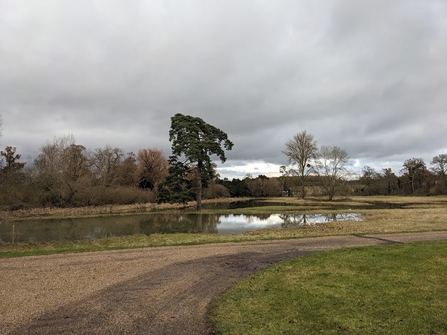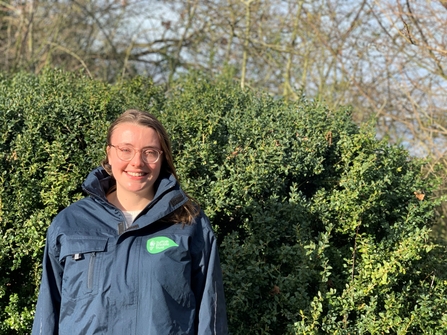Within a meadow at the project site, a winding linear depression can be seen running through the centre, which old maps show to be a historic river channel, that has since been filled in, straightened, and moved to the edge of the meadow. A key aspect of this project was to reconnect the river to it's historic floodplain, by reprofiling the land beside the riverbank to encourage water into the old river channel and other natural hollows within the meadow during high flows - where it can be stored and released slowly back into the main river through a pipe. The exceptionally wet winter has been an excellent test of how this site will behave in high flows - and hold back water it did!

The meadow next to the River Glem, holding flood water after floodplain reconnection work - Alice Wickman
By reconnecting the river and floodplain, we have created a seasonally wet meadow which will store flood water in the wetter moths, release water slowly, and then dry out during the warmer, summer months. This will benefit people and wildlife by slowing the flow of water, reducing flood risks downstream, and providing habitat for wintering waders, wildfowl, invertebrates, and other wildlife. These seasonal fluctuations in water levels will also encourage a diverse plant community in the meadow, such as those seen in historic floodplain meadows.
Three wetland scrapes were also created in different areas of the floodplain to provide important feeding areas for breeding wading birds, as well as habitat for other wildlife. Wetland scrapes are shallow, wetland features which usually hold water in the winter and spring through to the early summer when they draw down slowly, leaving shallow, insect-rich muddy edges which are vital feeding areas for breeding waders, such as redshank and lapwing.
As well as the floodplain work adjacent to the main river channel, we installed log flow deflectors to aid in restore the flow to it's historic path, prior to altering and straightening. These in-channel enhancements will significantly improve the river habitat by adding diversity to an otherwise uniform channel. The log flow deflectors will help divert the flow of water, creating local scour, deeper pool sections that are used by fish, and trap sediment which will improve the water quality downstream. The woody material in the river will also provide a surface for invertebrates to live on, which in turn will provide food for fish and other wildlife.
This project was funded by the Environment Agency and is part of a series of projects taking place across the Wool Towns Farm Cluster area. The Wool Towns Farmer Cluster is a group of farmers and landowners in West Suffolk, working together to improve the environment.

Alice Wickman
Alice Wickman is our Wilder Rivers Adviser. Managing river projects and delivering talks, Alice works with many community groups, farms, and landowners to help restore, clean and diversify Suffolk's rivers and landscape-scale waterways.






